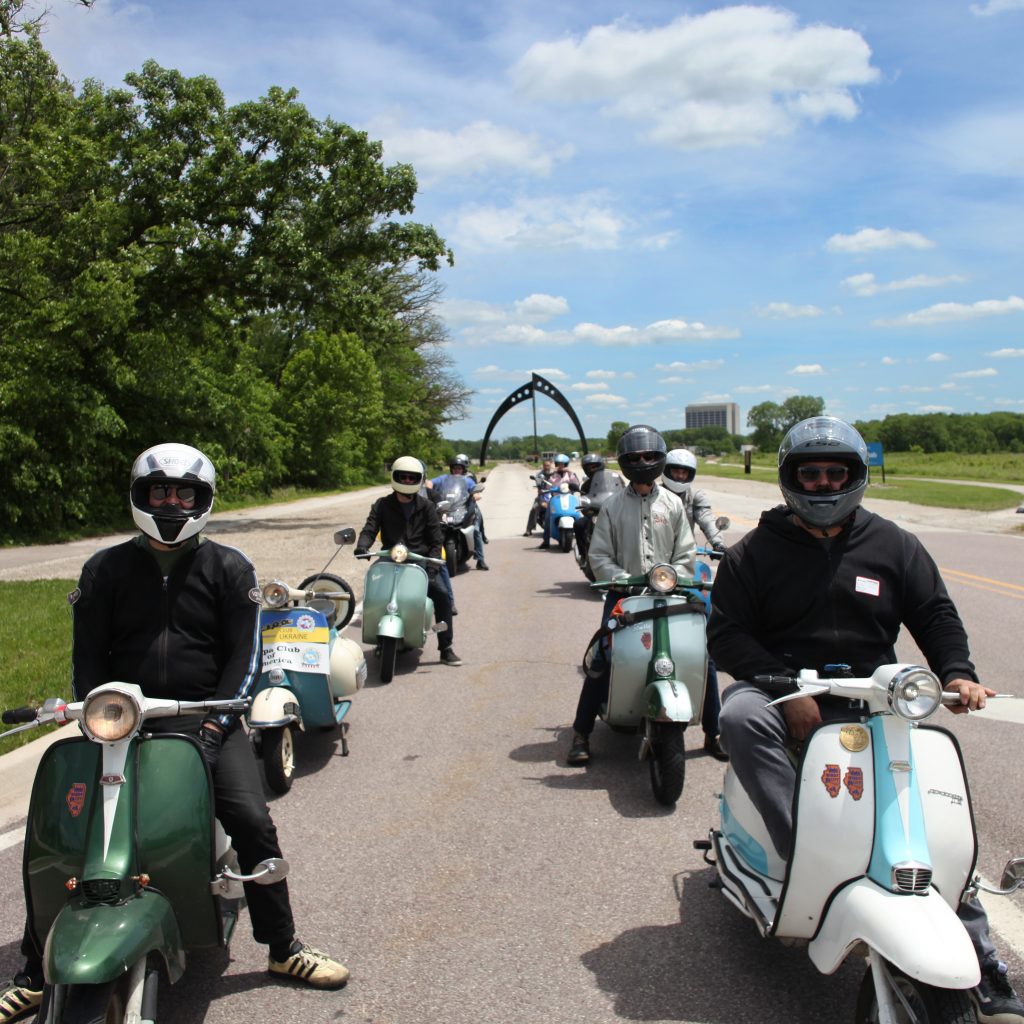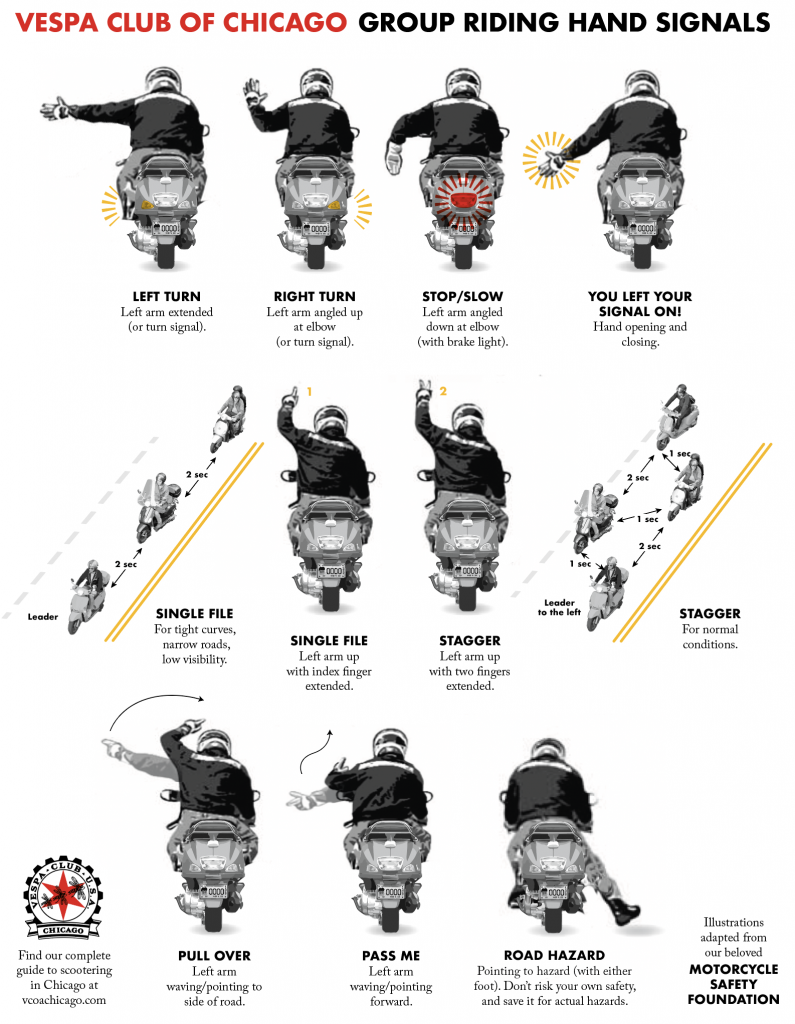
This guide is compiled from various sources, notably the Motorcycle Safety Foundation, and years of experience riding with a wide variety of groups. from a handful of friends to hundreds of riders at national rallies. Download a printable pdf here.
Arrive early, with a full tank of gas.
Be sure your bike is running properly. Check lights, brakes and tires. Charge your phone. Bring tools, spares, cash, credit card, sunscreen, water, license, registration, and insurance. Don’t forget your VCOA roadside assistance information!
Gear up!
Only eye protection is mandatory in Illinois, but smart riders wear a full-face helmet, gloves, sturdy shoes with ankle protection, and an armored jacket.
Listen carefully at the rider meeting
Ride organizers will discuss the route, stops, signals, communications, and procedures, and introduce you to the ride officials:
- Leader: stays in front, sets the pace, and navigates.
- Sweep: stays in back, keeps the group together.
- Chase: longer/bigger rides may have a truck/trailer to rescue vehicles and carry gear. The driver is missing the ride for your benefit, so be polite.
- Blockers: riders assigned to block intersections. Watch for them whipping past you in the medians. Never take it upon yourself to block traffic unless assigned and briefed by the leader.
If you’re inexperienced, please let the officials know. Don’t be afraid to ask questions. Even if you’re experienced, listen carefully, every group and situation is different. Don’t join a group ride unless you know the organizers’ rules, and are comfortable following them.
Know the pace, know your place
Ask (before the meetup) about the pace of the ride, to ensure your scooter and skill is appropriate. Slower scooters and less-experienced riders should line up in the front, behind the leader. Bigger/faster scooters should stay near the back.
Ride in staggered formation
For maximum safety, we ride in a staggered formation within one lane. Think of it as “staggered single file,” not two separate lanes. This formation allows maximum space around riders in case someone needs to swerve or brake to avoid a hazard. The leader stays to the left of the lane, avoiding the central “grease strip.” The next rider follows on the right side of the lane, with all other riders staggered behind them. Follow one second behind the rider diagonally in front of you, and two seconds behind the rider directly in front of you.
If the road gets narrow, curvy, or visibility is low, the leader may signal to merge into single file. Slow down to allow two seconds behind you and the rider in front of you.
In either formation, avoid riding side-by-side or passing other riders. If a vacant position appears, check around you, signal, and merge into the empty space. Other riders behind you should re-align accordingly. If you must pass other riders, do so with extreme caution.
Keep the group together
Check that riders around you are keeping together and adjust your pace accordingly. If the group is split by traffic or red lights, there are various strategies, note which combination of these your group will use:
- The ride leader signals to merge into single file and pull over until the rest of the group catches up.
- The original group continues, leaving a rider at the next turn to direct the rest of the group. Works great for large groups, if everyone is clear on the plan.
- The ride stays together, running stop signs/lights, with assigned “cowboys” blocking traffic as needed. It works, but it’s illegal and there is serious risk involved.
- Sometimes a ride really needs to stay on schedule, whuch calls for tough love. If you get left behind, catch up at the next location or rest stop.
- If several riders have compatible communication devices, they can guide smaller breakaway packs as needed, and keep the leader and sweep informed.
- You might agree in advance to stick with a friend on the ride, if one pulls over, the other will too, allowing the sweep rider to stay with the pack. Your buddy can help with repairs, give you a ride to civilization, or at least keep you company.
If you have to pull over or slow down, check blind spots, signal, and pull over to a safe spot. As the sweep rider approaches, give a thumbs-up (if you’re OK) or wave them towards you (for assistance).
Keep your eyes open
Never take it for granted that anyone (in your group, or otherwise) will do what they’re supposed to! Use your mirrors and turn your head frequently to check your blind spots. Any sudden unexpected action can have serious repercussions. Watch brake lights for cues. Don’t listen to music or fidget with your phone or camera, and keep chatter to a minimum on the coms. If there is a breakdown or collision, keep moving until the group is in a safe spot.
Be a good citizen
Riding with a group of mixed experience and displacement demands that everyone ride responsibly. It’s not the time for jackassery. Your choices and attitude affect everyone else in the group. If you’re distracted, frustrated, or uncomfortable, excuse yourself, ride solo to the next stop (or home) safely, and calmly/politely/privately communicate any grievances with the ride leader at an appropriate time.


